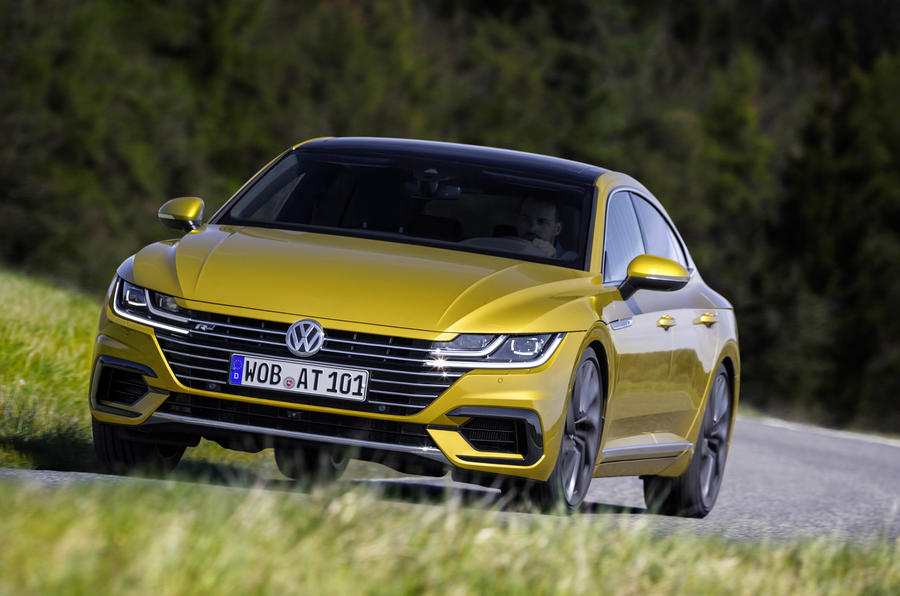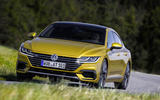What is it?
This is the top-of-the-range petrol version of Volkswagen’s new top-of-the-range fastback executive saloon, the Arteon.
And top-of-the-range or not, it’s got a reasonable shot at out-selling its diesel counterpart – not least because that’s not saying a great deal in the wake of the Dieselgate scandal. Also, however, because it qualifies for benefit-in-kind (BIK) company car tax at a lower percentage rate that its diesel rangemate, seeing as Volkswagen is highly likely to sell the car for less than the £40,000 threshold for £450-a-year premium road tax. It also remains to be seen whether there will be any significantly cheaper versions of the Arteon offered in UK showrooms.
This model gets 4Motion four-wheel drive as standard, as well as a seven-speed twin-clutch automatic gearbox, and is powered by the same EA888 2.0-litre turbocharged engine you’ll find in wide use across the Volkswagen Group. In the Arteon, it produces a Golf-GTI-beating 276bhp and gives a 0-62mph acceleration time of which many modern hot hatches would be rightly proud.
The Arteon will be offered to British buyers in two trim levels, Elegance and R-Line, with the latter getting lowered sport suspension springs to match its standard adaptive dampers. Our test car is in the latter trim.
What's it like?
As a rational proposition, the Arteon has plenty going for it – just as we reported of the diesel version. Style-centred executive options like this aren’t usually so roomy, and interior quality and equipment sophistication is good. It’s as the dreaded ‘emotional purchase’ that the Arteon's case begins to unravel, because, to these eyes at least, it’s certainly no style icon, and neither does it merit a place amongst the most engaging driver’s cars in this part of the executive saloon market.
The engine walks Volkswagen’s practiced line between hushed refinement and sporting aggression. It’s hushed at low speed and at a cruise, getting a little bit noisier (no doubt with help from the car’s stereo speakers) in Sport mode. It’s always matched very carefully to the automatic gearbox, allowing shifts to be delivered in a timely and smooth fashion.
With more than 1600kg to haul (and slightly less torque than it commonly develops in the Volkswagen Group’s latest round of cheaper performance cars), the 2.0-litre turbocharged engine doesn’t feel desperately potent, but it is typically flexible, responding keenly to the accelerator at all times and not feeling at all prescriptive about where within the rev range it’s willing to knuckle down. And so, like the diesel’s, the Arteon petrol’s performance feels brisk rather than fast – but nevertheless quick enough to command its place in the outside lane of the autobahn.
R-Line trim's sport suspension makes for a negligible improvement to the car’s ride and handling. There's a marginal sense of being more closely and consistently in touch with the surface of the road than in the Elegance-trim diesel we drove, but at no point do the adaptive dampers give you the taut, settled body control needed in order to make the Arteon feel truly sporting. In Sport mode, you’ll find the car’s motorway ride is simply slightly differently jiggling to that of the diesel, while its optional 20in wheels thump and crash a little over sharper intrusions just as those of the diesel’s do.





















Join the debate
Add your comment
Nice, but the interior doesn
Nice, but the interior doesn't look that different from my second hand Skoda - the climate controls look exactly the same, with those dated looking 90s Microwave Oven style LCD displays for the temperature.
Hugely practical though, biggest downside to the CC was that the bootlid opening was like a letterbox.
Id spend my money non a
Id spend my money non a similarly powered guilia veloce
.